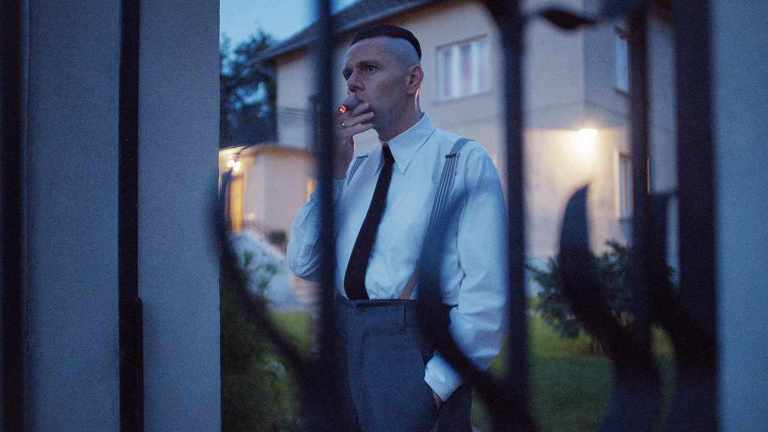The Zone of Interest Is the Scariest Movie of the Year
Jonathan Glazer’s The Zone of Interest dares the viewer to see themselves in the devil.

When we meet them, Rudolf and Hedwig are an ordinary couple with ordinary concerns. He wants a promotion at work, and she needs a loving home for their children to grow up in; he dotes on their pets, particularly his prized horse, and she must make sure the garden is ready to bloom come the spring and all the lawn parties that attend it. Both are fixated on making sure their children are happy.
Jonathan Glazer depicts their lives as the most mundane of domestic concerns. Yet it’s the fact the director never points his camera to what lies beyond Hedwig’s garden, and above the high wall which looks down upon their happy home, that will give you a dreadful, stomach-churning pause. We simply hear the muffled sounds of what Rudolf’s built there, and glimpse the foundations for this idyllic German dream in occasional shots of black smoke clouds wafting across a winter sky.
This is a blissful portrait of the family life of Rudolf Höss, a high ranking German SS officer and commandant of Auschwitz. He raised his children at the mouth of hell—heck, he even designed the gate. And it is the utter normality in such environs that The Zone of Interest becomes the most disturbing, and perhaps most thought-provoking, film of the year.
The real-life Rudolf Höss indeed lived in a villa located right outside Auschwitz, the concentration camp where he and his most assiduous of subordinates revolutionized the efficiencies of mass murder and genocide. It was Höss who introduced Zyklon B, a pesticide gas used to murder more than one million Jewish people in the showers of Höss’ camp. It was such a successful innovation, Hitler promoted him in gratitude for his resourcefulness.
Those are the bleak, almost incomprehensible facts of history and the man. And yet, the reason Glazer’s film is so evocative and urgent is that it doesn’t seek to be a sober account of the Holocaust. Instead this movie is something slightly more obtuse and therefore infinitely more insidious. For all intents and purposes, this is a family’s home movies, and they’re inviting every viewer to see themselves in the banalities and compromises made by people who not only profited off the slaughter of millions, but thrived from it.
The film opens with Rudolf (Christian Friedel) and Hedwig (Sandra Hüller, who is having an extraordinary year between this and Anatomy of a Fall) partaking in a lakeside holiday in the beautiful Polish countryside. In the distance they might see some trains, or later a Jewish prisoner or two, but by and large they’re intentionally looking away from what is right under their nose.
There are, in fact, sequences of Hedwig being able to choose from the finest fur coats confiscated from faceless Jewish families. In another scene, she shows her mother around her garden that is punctuated by splashes of red roses. Both women pretend not to hear the cries from behind the wall beside all these flowers, with their willful ignorance only broken when their dog begins barking at the ferocious sounding hounds next door. Finally, the grandmother wonders if the Jewish woman she used to work for as a maid is on the other side… She then congratulates her daughter for landing such a useful husband and lavish lifestyle.
Glazer essays the blatant banality of evil with a deceptively disinterested gaze. By employing a cinema verite, nigh documentarian aesthetic, the filmmaker copies the real-life Höss family, who historically staged all the photos of their beloved family house while pointing the camera in the opposite direction of Auschwitz. They knew the source of all their wealth and good times was not an image they’d like to preserve for posterity. And while none are more culpable than the commandant, their implicit need to look away betrays the lie of so many Germans who claimed they never knew what was occurring in those camps. They too just looked the other way when the trains rolled by.
By the end of The Zone of Interest, the Höss boys’ sibling rivalry is so intense that it becomes the point of a scene, with both children oblivious of the ominous, now fully black cloud dominating the sky. Glazer films the sequence with the children as the focus, and the smoke appearing in the background like an unwelcome photobomber.
This peculiar approach to the material is as uncomfortably vital to our moment as it is chilling. So often in movies, Nazis are depicted as incomprehensibly evil or cartoonishly vile. To be sure, they were evil and vile in equal measure, but it’s become too easy to reduce them to caricature or a kind of myth from the past; humans who were themselves inhuman. But they lived real lives with real daily, understandable concerns, and they all (some more than others) made little compromises that most assuredly backslid the entire world into the abyss.
By turning the camera away from the abyss, however, Glazer’s The Zone of Interest asks the viewer to recognize that dark void within ourselves right now, and how similar we can become to Rudolf and Hedwig’s slice of paradise. So if you cannot spot the same desire to rationalize and normalize our own current uncomfortable realities—be it with unhoused poverty on the street, children rounded up and placed in cages, or the same leaders who once said an orange-faced authoritarian “bears responsibility” for an insurrectionist mob now working tirelessly to restore that authoritarian to power—then you might have already been seduced by the fur coats. But averting the gaze will not wash away the sin, or the ever-growing cloud of doom billowing above our heads.
The Zone of Interest opens in the U.S. on Dec. 15 and in the UK on Feb. 2, 2024.
